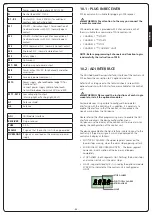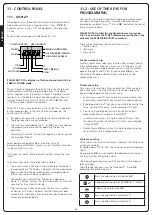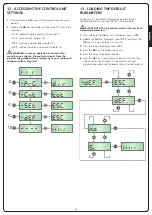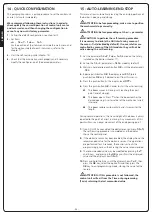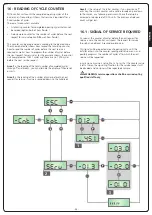
ENGLISH
- 63 -
AUTOMATION DEVICE USERS MANUAL
AUTOMATION DEVICE USER INFORMATION
An automation system is a great convenience, in addition to a valid security system, and with just a little, simple care, it is made to last
for years.
Even if your automation device meets all the safety standards, this does not exclude the presence of residual risk, i.e. the possibility that
hazardous situations may be created, usually due to irresponsible or even improper use, and for this reason we wish to offer some advice
regarding the behaviour to be adopted in order to avoid problems:
Prior to using the automation device for the first time
, ask the installer to explain the sources of residual risk to you, and take some
time to read the instruction manual and user information delivered by the installer.
Keep the manual for any future doubts and give it to any new owners of the device.
Your automation device is a machine that faithfully follows your commands
; irresponsible and improper use can make it become
hazardous: do not start movement of the device if there are people, animals or objects within its radius of action.
Children
: installed in accordance with technical regulations, an automation system guarantees a high level of safety.
However, it is prudent to prevent children from playing near the automation device and to avoid unintentional use; never leave the
remote control within the reach of children: it is not a toy!
Anomalies
: as soon as the automation device shows any anomalous behaviour, remove the electricity supply and perform manual
unblocking. Do not attempt any repairs yourself, but ask your installer: in the meantime, the system can operate as a non-automated
device.
Maintenance
: as with all machinery, your automation devices requires periodic maintenance so that it may continue to work for as long
as possible, and in complete safety. Agree a periodic maintenance plan with your installer; V2 SpA recommends a maintenance plan to
be performed every 6 months for normal domestic use, but this period may vary depending on the intensity of use.
Any inspection, maintenance or repairs should only be performed by qualified personnel. Even if you think you know how, do not
modify the system and the automation device programming and adjustment parameters: your installer is responsible for this.
Final testing, periodic maintenance and any repairs should be documented by those performing the operations, and the documents held
by the system owner.
Disposal
: on completion of the device’s operating life, ensure that disposal is performed by qualified personnel and that the materials
are recycled or disposed of in accordance with valid local regulations.
Important
: If your device is fitted with a radio control, the function of which appears to deteriorate over time, or has even ceased to
function, this might simply depend on the batteries being run down (depending on the type, this may be from several months to up to
two/three years). Before contacting your installer, try replacing the battery with the battery from another, working transmitter: if this was
the cause of the problem, then simply replace the battery with another of the same type.
Are you satisfied?
Should you wish to add another automation device to your home, contact the same installer and ask for a V2 SpA
product: we guarantee you the most advanced products on the market and maximum compatibility with existing automation devices.
Thank you for having read these recommendations, and for any present or future needs, we ask you to contact your installer in full
confidence.
EMERGENCY LOCK
RELEASE
In case of power loss, bypassing the
motor manually can unblock the barrier
mechanically.
Insert the key provided with the
equipment in the lock, make 1/4 of a
turn in clockwise sense and rotate the
handle towards the left: the boom is
free and can be opened manually.
To restore automation simply rotate to
the initial position and again rotate the
key to the closed position.
Summary of Contents for NIUBA-24V
Page 2: ...1153 mm 320 mm 287 mm 218 mm 897 mm 1168 mm 374 mm 239 mm 319 mm 897 mm ...
Page 7: ...ITALIANO 5 NIUBA4 NIUBA6 ...
Page 11: ...ITALIANO 9 FIG 3 FIG 4 ...
Page 13: ...ITALIANO 11 A D E C F F G E A B D C O N M ...
Page 31: ...ITALIANO 29 ...
Page 34: ...ITALIANO 32 ...
Page 39: ...ENGLISH 37 NIUBA4 NIUBA6 ...
Page 43: ...ENGLISH 41 FIG 3 FIG 4 ...
Page 45: ...ENGLISH 43 A D E C F F G E A B D C O N M ...
Page 63: ...ENGLISH 61 ...
Page 66: ...ENGLISH 64 ...
Page 71: ...FRANÇAIS 69 NIUBA4 NIUBA6 ...
Page 75: ...FRANÇAIS 73 FIG 3 FIG 4 ...
Page 77: ...FRANÇAIS 75 A D E C F F G E A B D C O N M ...
Page 95: ...FRANÇAIS 93 ...
Page 98: ...FRANÇAIS 96 ...
Page 103: ...ESPAÑOL 101 NIUBA4 NIUBA6 ...
Page 107: ...ESPAÑOL 105 FIG 3 FIG 4 ...
Page 109: ...ESPAÑOL 107 A D E C F F G E A B D C O N M ...
Page 127: ...ESPAÑOL 125 ...
Page 130: ...ESPAÑOL 128 ...
Page 131: ......

